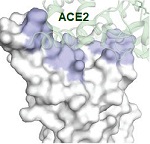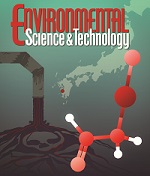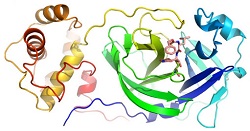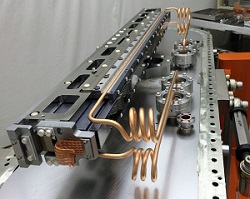
From the Director

As described elsewhere in this edition of SSRL Headline News, the Lightsource entered a shortened summer downtime in mid-July and we will restart operations in early September. On restarting, the initial focus will be on remote operations in which experiments are assisted or performed by SSRL staff and with sample mail-in. We will look to reintroduce a limited number of on-site users later in the autumn. Recovery of operations at SSRL will occur gradually, in keeping with local and state public health ordinances and, as always, with an emphasis on safety. We are committed to working with the broad community of SSRL users to find creative ways to advance their science.
– Paul McIntyre
Science Highlights

SARS-CoV-2 Spike Protein Targeted for Vaccine – Contact: Ian Wilson, The Scripps Research Institute
The COVID-19 pandemic triggered by the SARS-CoV-2 coronavirus is causing health and economic havoc on a global scale requiring the development of an effective vaccine and therapeutics. Spike proteins found on the viral surface of SARS-CoV-2 attach to human cells to gain entry. Neutralizing antibodies which target these same spike proteins of the CoV-2 virus would effectively block viral entry.
A research team reviewed data on ~300 antibodies from convalescent patients that target SARS-CoV-2 and found that the gene IGHV3-53 was the most frequently used to produce these antibodies. Read more...

Modern Methods Applied to a Past Poisoning at Minamata Japan – Contact: Graham George, University of Saskatchewan
In the 1950’s and 60’s a poisoning occurred in Minamata Japan. In addition to the people, the local cat population was affected with what was called “Dancing Cat Disease” and shortly thereafter neurological signs and symptoms became more prominent in people. The sickness became known as Minamata Disease. Eventually it was shown to be a form of organic mercury poisoning. During the episode, pregnant women who were minimally or not obviously affected delivered infants who had neurological disorders such as seizures, microcephaly, and cerebral palsy.
The local company that caused the pollution employed a physician who played a role in determining the cause. He found that cats fed chemical effluent from the factory quickly developed signs similar to those seen in people with Minamata Disease. He preserved samples of brain tissue from one of the cats, and remarkably, these samples still exist. An international team of researchers used sophisticated modern techniques to analyze these samples and determine the chemical form of mercury within the tissue. Read more...
SSRL-Related Science and News
In a Search for COVID-19 Treatments, Researchers Pursue a Drug Used on Cats
Excerpt from SLAC News article based on press release from the University of Alberta

Researchers at the University of Alberta have shown that a drug used to treat deadly coronavirus infections in cats could potentially be an effective treatment against SARS-CoV-2, the virus behind the global coronavirus pandemic. The results were published August 27 in the journal Nature Communications.
The study, which was aided by scientists at SSRL, paves the way for human clinical trials, which should begin soon, said Joanne Lemieux, a Professor of Biochemistry at the University of Alberta and the study’s senior author.
“This drug is very likely to work in humans, so we’re encouraged that it will be an effective treatment for COVID-19 patients,” Lemieux said, although the clinical trials will need to run their course before anyone can be sure that the drug, a protease inhibitor called GC376, is both safe and effective for treating COVID-19 in humans. Read more...
Beam Line 12-1 Aids COVID-19 Research
Excerpt from SLAC News article by Nathan Collins

SSRL's new beam line 12-1 combines an extra bright, tightly focused x-ray beam with robotics, automation, full remote access and data processing systems to expand the types of macromolecules research teams can study. In just the first few months of part-time user operations on the beam line researchers from Stanford University, The Scripps Research Institute, the University of California, San Francisco and the California Institute of Technology have studied proteins thought to be central to SARS-CoV-2 infection.
The new beam line construction was funded mainly by Stanford University, The Scripps Research Institute, several private foundations through Stanford University, and the National Institutes of Health. In BL12-1, said Scripps Professor Ian Wilson, SSRL has one of the most advanced “microfocus” x-ray beam lines in the world. “We’ll be able to use smaller crystals, collect higher quality data, get a better signal-to-noise ratio and collect more data sets per hour” than ever before, Wilson said. Read more...
How Clean Water Technologies Could Get a Boost from X-ray Synchrotrons
Excerpt from SLAC News article by Nathan Collins
The world needs clean water, and its need is only going to grow in the coming decades. Yet desalination and other water-purifying technologies are often expensive and require a lot of energy to run, making it that much harder to provide more clean water to a growing population in a warming world.
To move forward, researchers should use tools such as those available at x-ray synchrotrons to better measure the properties of materials involved in purifying salty or otherwise contaminated water, argue a team of scientists from SSRL and the University of Paderborn in Germany.
“This is an opportune time for the country really – national labs, academia and industrial partners – to advance the science related to desalination” and other clean water technologies, said Michael Toney, a distinguished scientist SSRL at the time, now a faculty member in Chemical and Biological Engineering at the University of Colorado, Boulder. Toney together with coauthors SSRL scientist Sharon Bone and Paderborn’s Professor Hans-Georg Steinrück have just published a new perspective on advancing clean water technology in the journal Joule. Read more...
SSRL Awards
Peter Chung Wins 2020 Spicer Young Investigator Award for Work on Neurodegenerative Disease
Excerpt from SLAC News article by Nathan Collins

Peter Chung, the Kadanoff-Rice Postdoctoral Fellow at the University of Chicago, wants to understand neurodegenerative disease in its finest detail, at the level of proteins that form tangles in neurons and lead, researchers believe, to ailments including Parkinson’s and Alzheimer’s diseases.
Chung has spent many hours of his career running experiments on the biological small-angle x-ray scattering (bioSAXS) beam line 4-2 at SSRL aimed at untangling the mysteries of those proteins, often developing new methods to do so, and for his efforts, he has won SSRL’s 2020 Spicer Young Investigator Award. Read more..
User Operations
After a brief shutdown, restarting SPEAR3 and activities to bring up beam lines are well underway. Our original summer maintenance shutdown was revised in coordination with the other DOE light sources to facilitate continued access to synchrotrons and support COVID-19-related user experiments. We plan to resume user operations in early September, with x-ray experiments being performed primarily by beam line staff. Significant effort is also being devoted to building effective sample mail-in and remote access programs for many beam lines. We aim to gradually introduce local (Northern California) users to the experimental floor toward the end of 2020.
Events
- SSRL EXAFS Summer School, Sep 8–10, 2020 (virtual) website
- SSRL/LCLS Users' Meeting and Workshops, Sep 28–Oct 9, 2020 (virtual)
Plan to attend the SSRL/LCLS Annual Users’ Meeting and Workshops, a virtual meeting held the mornings of September 28 through October 9, 2020. The meeting will include facility updates, a DOE BES update, invited talks, and several focused workshops. website - LCLS Workshop on Non-L inear Multidimensional Methodologies for Studying Chemical Sciences, Dec 9–10, 2020 (virtual)
User Research Administration
Proposal Deadlines
- Xray/VUV – November 1, 2020
- Macromolecular Crystallography – December 1, 2020
- COVID-19 related proposals for beam time at SSRL and microscope time at our CryoEM facility can be submitted at any time and will be reviewed expeditiously.
- CryoEM biology-related proposals for the S2C2 program can be submitted at any time through the end of 2020. Proposals will be reviewed on a monthly basis.
Submit beam time requests and proposals through the User Portal. Questions can be directed to the SSRL User Office or the CryoEM User Office
The Stanford Synchrotron Radiation Lightsource (SSRL) is a third-generation light source producing extremely bright x-rays for basic and applied research. SSRL attracts and supports scientists from around the world who use its state-of-the-art capabilities to make discoveries that benefit society. SSRL, a U.S. DOE Office of Science national user facility, is a Directorate of SLAC National Accelerator Laboratory, operated by Stanford University for the U.S. Department of Energy Office of Science. The SSRL Structural Molecular Biology Program is supported by the DOE Office of Biological and Environmental Research, and by the National Institutes of Health, National Institute of General Medical Sciences. For more information about SSRL science, operations and schedules, visit http://www-ssrl.slac.stanford.edu.
To unsubscribe from SSRL Headlines, just send an e-mail to listserv@slac.stanford.edu with "signoff ssrl-headlines" in the body.
To subscribe, send an e-mail to with "subscribe ssrl-headlines" in the body.
Questions? Comments? Contact Lisa Dunn




